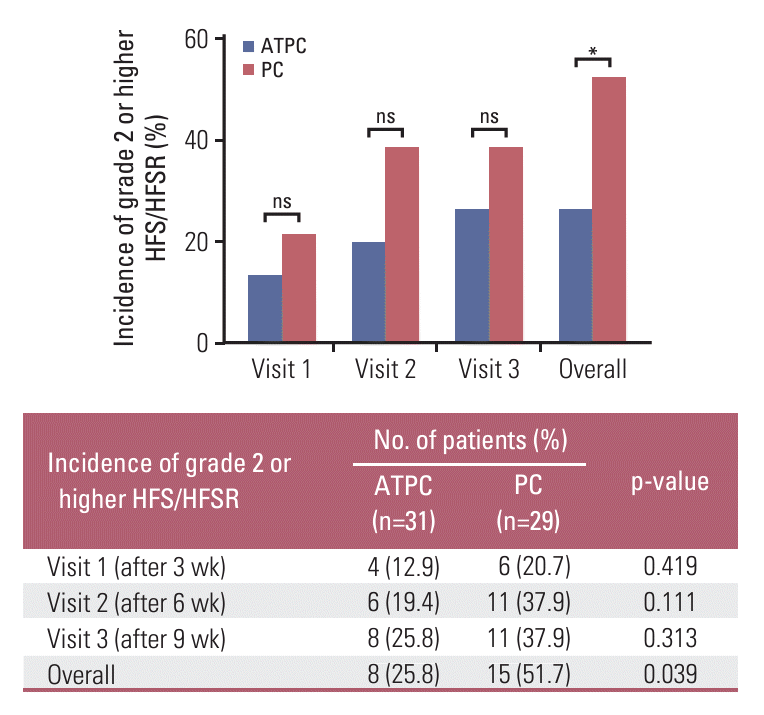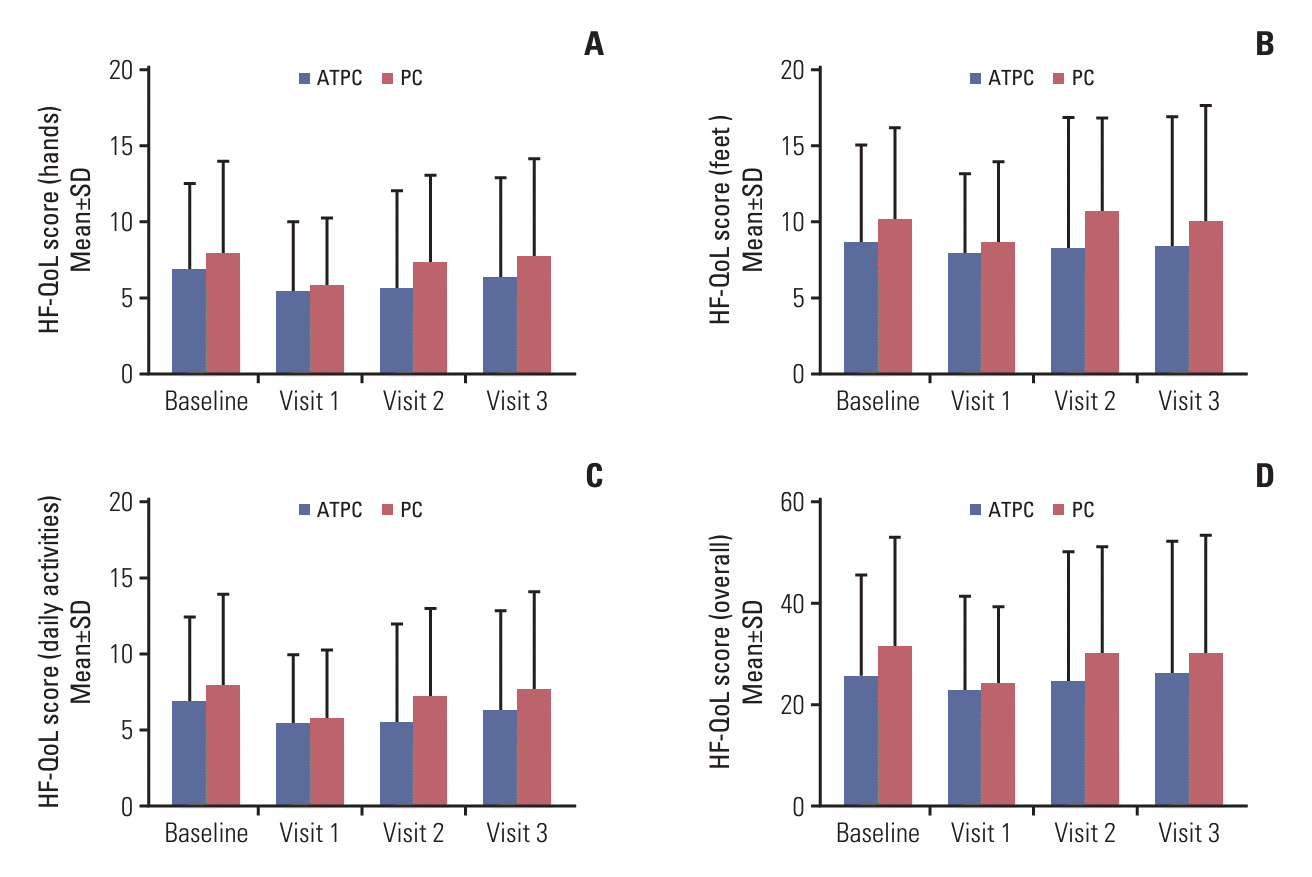1. Chen J, Wang Z. How to conduct integrated pharmaceutical care for patients with hand-foot syndrome associated with chemotherapeutic agents and targeted drugs. J Oncol Pharm Pract. 2021; 27:919–29.

2. Miller KK, Gorcey L, McLellan BN. Chemotherapy-induced hand-foot syndrome and nail changes: a review of clinical presentation, etiology, pathogenesis, and management. J Am Acad Dermatol. 2014; 71:787–94.
3. Degen A, Alter M, Schenck F, Satzger I, Volker B, Kapp A, et al. The hand-foot-syndrome associated with medical tumor therapy: classification and management. J Dtsch Dermatol Ges. 2010; 8:652–61.
4. Lou Y, Wang Q, Zheng J, Hu H, Liu L, Hong D, et al. Possible pathways of capecitabine-induced hand-foot syndrome. Chem Res Toxicol. 2016; 29:1591–601.

7. Lee KJ, Kim Y, Yoo YH, Kim MS, Lee SH, Kim CG, et al. CD99-derived agonist ligands inhibit fibronectin-induced activation of beta1 integrin through the protein kinase A/SHP2/extracellular signal-regulated kinase/PTPN12/focal adhesion kinase signaling pathway. Mol Cell Biol. 2017; 37:e00675. –16.

8. Zou DP, Chen YM, Zhang LZ, Yuan XH, Zhang YJ, Inggawati A, et al. SFRP5 inhibits melanin synthesis of melanocytes in vitiligo by suppressing the Wnt/beta-catenin signaling. Genes Dis. 2021; 8:677–88.
9. Liu J, Xiao Q, Xiao J, Niu C, Li Y, Zhang X, et al. Wnt/beta-catenin signalling: function, biological mechanisms, and therapeutic opportunities. Signal Transduct Target Ther. 2022; 7:3.
10. Bos JD, Meinardi MM. The 500 Dalton rule for the skin penetration of chemical compounds and drugs. Exp Dermatol. 2000; 9:165–9.

12. Anderson RT, Keating KN, Doll HA, Camacho F. The hand-foot skin reaction and quality of life questionnaire: an assessment tool for oncology. Oncologist. 2015; 20:831–8.

13. Nam SH, Choi HJ, Kang WD, Kim SM, Lim MC, Park SY, et al. Development and validation of the Korean version of Hand-Foot Skin Reaction and Quality of Life Questionnaire (HF-QoL-K). J Korean Med Sci. 2016; 31:1969–75.

14. Kang YK, Lee SS, Yoon DH, Lee SY, Chun YJ, Kim MS, et al. Pyridoxine is not effective to prevent hand-foot syndrome associated with capecitabine therapy: results of a randomized, double-blind, placebo-controlled study. J Clin Oncol. 2010; 28:3824–9.

15. Zhou Y, Peng L, Li Y, Chen L. Prophylactic pyridoxine was not able to reduce the incidence of capecitabine-induced hand-foot syndrome: a meta-analysis. Biomed Rep. 2013; 1:873–8.

16. Chen M, Zhang L, Wang Q, Shen J. Pyridoxine for prevention of hand-foot syndrome caused by chemotherapy: a systematic review. PLoS One. 2013; 8:e72245.

17. Yap YS, Kwok LL, Syn N, Chay WY, Chia JWK, Tham CK, et al. Predictors of hand-foot syndrome and pyridoxine for prevention of capecitabine-induced hand-foot syndrome: a randomized clinical trial. JAMA Oncol. 2017; 3:1538–45.

18. Zhang RX, Wu XJ, Wan DS, Lu ZH, Kong LH, Pan ZZ, et al. Celecoxib can prevent capecitabine-related hand-foot syndrome in stage II and III colorectal cancer patients: result of a single-center, prospective randomized phase III trial. Ann Oncol. 2012; 23:1348–53.

19. Chen JC, Wang JC, Pan YX, Yi MJ, Chen JB, Wang XH, et al. Preventive effect of celecoxib in sorafenib-related hand-foot syndrome in hepatocellular carcinoma patients, a single-center, open-label, randomized, controlled clinical phase III trial. Am J Cancer Res. 2020; 10:1467–76.
20. Macedo LT, Lima JP, dos Santos LV, Sasse AD. Prevention strategies for chemotherapy-induced hand-foot syndrome: a systematic review and meta-analysis of prospective randomised trials. Support Care Cancer. 2014; 22:1585–93.

21. Huang XZ, Chen Y, Chen WJ, Zhang X, Wu CC, Wang ZN, et al. Clinical evidence of prevention strategies for capecitabine-induced hand-foot syndrome. Int J Cancer. 2018; 142:2567–77.

22. Wolf SL, Qin R, Menon SP, Rowland KM Jr, Thomas S, Delaune R, et al. Placebo-controlled trial to determine the effectiveness of a urea/lactic acid-based topical keratolytic agent for prevention of capecitabine-induced hand-foot syndrome: North Central Cancer Treatment Group Study N05C5. J Clin Oncol. 2010; 28:5182–7.

23. Hofheinz RD, Gencer D, Schulz H, Stahl M, Hegewisch-Becker S, Loeffler LM, et al. Mapisal versus urea cream as prophylaxis for capecitabine-associated hand-foot syndrome: a randomized phase III trial of the AIO Quality of Life Working Group. J Clin Oncol. 2015; 33:2444–9.

24. Lan TC, Tsou PH, Tam KW, Huang TW. Effect of urea cream on hand-foot syndrome in patients receiving chemotherapy: a meta-analysis. Cancer Nurs. 2022; 45:378–86.

25. Gialaim Purcino Dos Reis FC, Meneses AG, Mazoni SR, Pereira Silveira RC, Diniz Dos Reis PE, Vasques CI. Topical interventions for preventing hand-foot syndrome resulting from antineoplastic therapy: a scoping review. Rev Esc Enferm USP. 2023; 57:e20220107.

26. Pandy JG, Franco PI, Li RK. Prophylactic strategies for hand-foot syndrome/skin reaction associated with systemic cancer treatment: a meta-analysis of randomized controlled trials. Support Care Cancer. 2022; 30:8655–66.

27. Barcella CA, Lamberts M, McGettigan P, Fosbol EL, Lindhardsen J, Torp-Pedersen C, et al. Differences in cardiovascular safety with non-steroidal anti-inflammatory drug therapy: a nationwide study in patients with osteoarthritis. Basic Clin Pharmacol Toxicol. 2019; 124:629–41.
28. Garcia-Rayado G, Navarro M, Lanas A. NSAID induced gastrointestinal damage and designing GI-sparing NSAIDs. Expert Rev Clin Pharmacol. 2018; 11:1031–43.

29. Harvey J, Lax SJ, Lowe A, Santer M, Lawton S, Langan SM, et al. The long-term safety of topical corticosteroids in atopic dermatitis: a systematic review. Skin Health Dis. 2023; 3:e268.

30. Shinohara N, Nonomura N, Eto M, Kimura G, Minami H, Tokunaga S, et al. A randomized multicenter phase II trial on the efficacy of a hydrocolloid dressing containing ceramide with a low-friction external surface for hand-foot skin reaction caused by sorafenib in patients with renal cell carcinoma. Ann Oncol. 2014; 25:472–6.








 PDF
PDF Citation
Citation Print
Print



 XML Download
XML Download